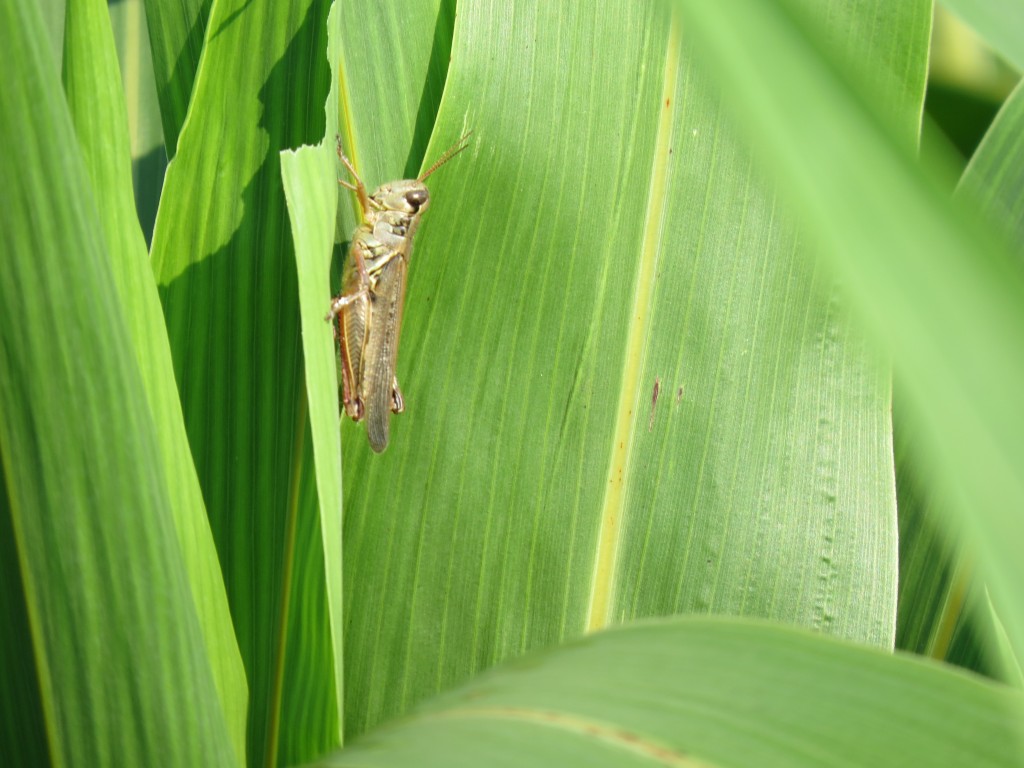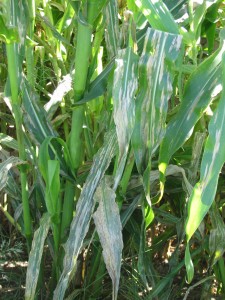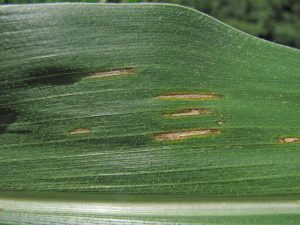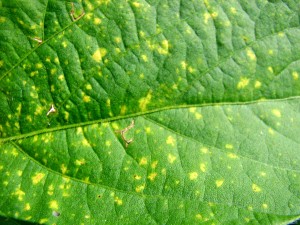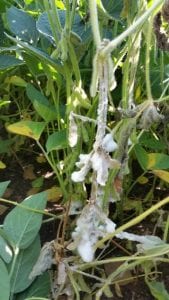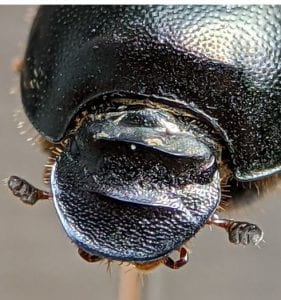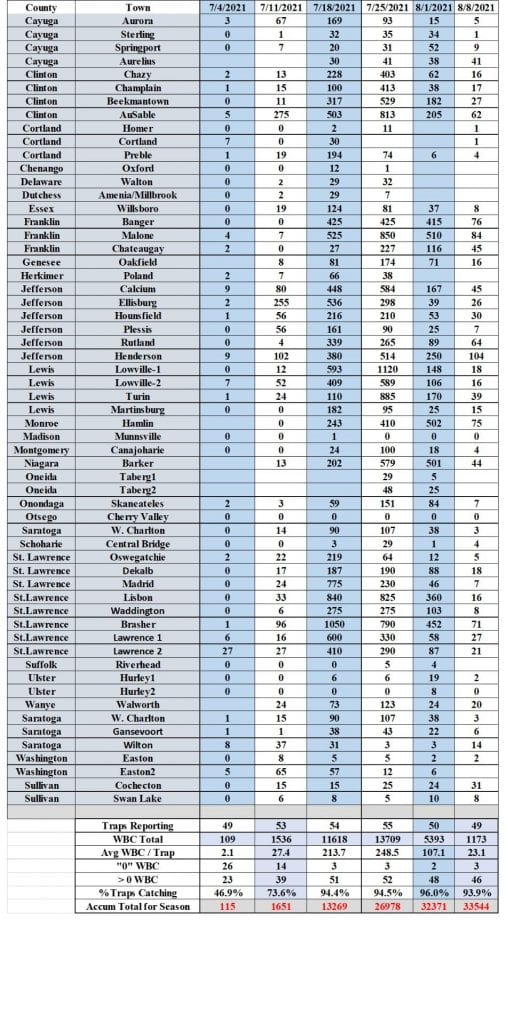NYS IPM Weekly Field Crops Pest Report
Western Bean Cutworms
We are past the peak flight for western bean cutworm moths in New York. We had an early peak flight again. Two years in a row, it was the last week in July. We will still be collecting data for a few more weeks. It is interesting that the peak flight average moth capture per trap is very similar since 2016. This year we had 248.5 moths/trap. Before 2016, the average per trap was much lower at peak flight.
Grasshoppers
There are reports of high levels of grasshoppers. Most species of grasshopper prefer feeding on pasture, small grains and hay grasses, but will feed on corn and soybeans. For more information on grasshoppers in pasture and hay fields please refer to the following website: https://extensionpublications.unl.edu/assets/pdf/g1630.pdf
Corn and Soybean Diseases
There have been reports of many corn and soybean foliar diseases across the state this week. These are as follows:
Corn
Soybeans
White Mold or Sclerotinia Stem Rot
Dung Beetles Study in NYS Cattle Pastures
As many of you know, I have been conducting a pilot study on the abundance and diversity of dung beetles in manure pats on pastures with cattle. Dung beetles compete with horn and face flies in manure pats in pastures as a means of indirect biological control. There are three types of dung beetles. Rollers (Geotrupes species), form balls of manure, which they push from the pat to bury as brood balls. Dwellers (Aphodius species), consume the manure as they tunnel within the dung pat and lay eggs directly in the manure and surrounding soil. Tunnelers (Onthophagus species), burrow beneath the manure to bury brood balls. Tunnelers and to lesser extent dwellers are effective at recycling manure back into the soil quickly. When they are all together working a manure pat can disappear within 36 to 48 hours. By removing the manure, they eliminate horn and face flies’ ability to develop. The removal of dung quickly depends on the complex of species of dung beetles in pastures.
I am currently working on identifying the weekly collection of beetles. We have collected 10 species of dung beetles currently and will expect to find more. I have only processed 3 weeks of collections. We will have 20 weeks of samples to identify. So far this is what we have found:
Aphodius
- granarius
- erraticus
- fimetarius
- haemorrhoidalis
- ruricola
- pseudolividus
Onthophagus
- orpheus
- taurus
- hecate
Hydrophilidae
1. Sphaeridium
We are collecting beetles weekly from May 1 to October 1. By late fall we should have some great data to share on the abundance and diversity of dung beetles in manure pats on pastures with cattle
Western Bean Cutworm Moth Catches by Location in NYS
Clipboard Checklist
Keith Waldron, NYS IPM
General
*Walk fields to check general field condition, weed, vertebrate and other issues
*Watch for crop maturity, stand assessments, weed escapes, nutrient deficiencies, lodging issues
Alfalfa:
*Evaluate established legume stands for approximate days until harvest
*Monitor potato leafhopper, foliar, systemic and crown rot diseases.
*Monitor new seedings for potato leafhopper, pythium blight, phytopthora root rot.
Small Grains:
*Monitor grain fields for growth stage, disease and lodging issues, grain maturity, harvest timing
*Record diseases present, location and types of weed escapes
Corn:
*Monitor for mid-season corn pests including European corn borer, corn rootworm, western bean cutworm, slugs, foliar diseases such as northern corn leaf blight and gray leaf spot, weed issues, nutrient deficiencies, vertebrate damage.
Soybeans:
*Monitor for soybean aphid, defoliators, foliar diseases, white mold, weed issues, vertebrate damage
Pastures:
*Check water sources, mend fences as needed.
*Check crop growth, clip pastures between grazing as needed
*Monitor for invasive species, plants harmful to livestock
*Review/Plan rotations
Storage:
* Check stored grain bins for temperature, moisture and signs of mold and insects. Aerate, core, transfer grain or treat as necessary
* Clean and disinfect empty storage bins in preparation for grain harvest
*Check forage allocation and anticipate feed program adjustments as forages from previous year are used up
*Mow around storage bins and facility to minimize pest hiding places
Dairy Cattle Barn Fly Management:
*Monitor animals and barn area for house fly, stable fly and other pest management needs including presence of rodents and birds.
*Check facilities for favorable fly breeding conditions: (organic matter + moisture): leaks in watering systems, roof gutters for leaks and potential overspill, drainage,
*Sanitation, sanitation, sanitation – clean animal resting areas, feed troughs, minimize source of moist organic matter i.e. fly breeding areas in barn and in adjacent animal loafing yard
* Continue fly monitoring: install “3X5″ index card fly speck monitoring cards throughout barn
*Use, replenish, replace fly management materials: sticky fly tapes/ribbons, insecticide baits, natural enemies (parasitoids), fly population monitoring (3 x 5) spot cards
*Consider purchase and release of Muscidifurax raptor and/or M. raptorellus natural enemies of house and stable fly pupae.
Dairy Cattle on Pasture:
*Monitor animals for presence of face flies, horn flies and stable flies. Action guidelines: face flies (average 10 per animal face), horn flies (average 50 / dairy per animal side, 200 / beef cattle per animal side), stable flies average 10 per animal (all four legs)
*Check feed bunk / water source locations for signs of stable fly breeding (moist undisturbed organic matter – spilled feed, round bales, etc.), minimize source of moist organic matter i.e. fly breeding areas in barn and in adjacent animal exercise yard.
*Check pasture for forage quality / quantity, rotate as appropriate
*Check pasture for vegetation poisonous to livestock
*Consider use of pasture fly traps to help reduce deer, horse and stable fly populations


